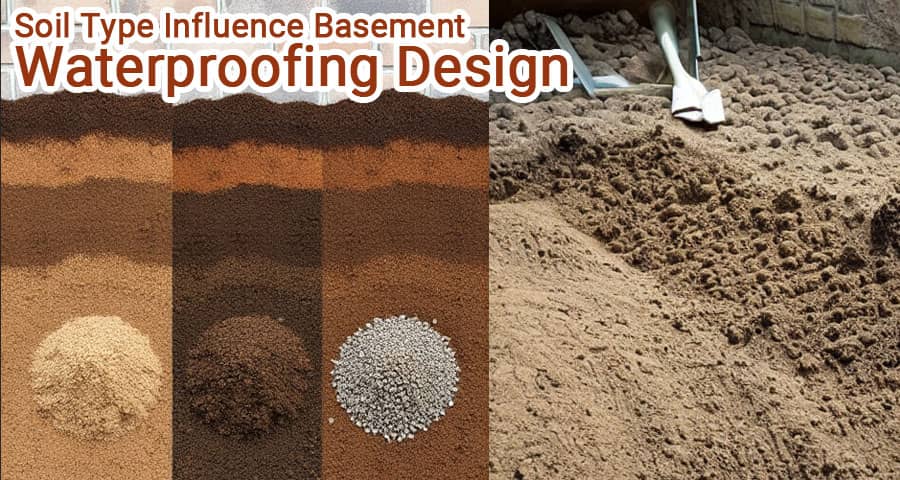How Can Soil Type Influence Basement Waterproofing Design?

Understanding the Impact of Soil Type on Basement Waterproofing
Basement waterproofing is a critical aspect of foundation design, ensuring that moisture does not penetrate the structure and cause damage. One of the most significant factors influencing waterproofing decisions is soil type. Different soils have varying levels of permeability, drainage capacity, and expansion properties, all of which impact how water interacts with a foundation.
Clay Soil and Its Challenges for Waterproofing
Clay soil, often known for its high water retention capacity, poses serious challenges for basement waterproofing. When exposed to moisture, clay expands, exerting hydrostatic pressure against basement walls. This pressure can lead to foundation cracks and water infiltration. During dry conditions, clay contracts, creating gaps that allow water to seep into the foundation when it rains again.
Waterproofing Solutions for Clay Soil
- Exterior Waterproof Membranes: A high-quality waterproof membrane on the exterior foundation walls helps resist water penetration.
- Proper Drainage Systems: Installing French drains or sump pump systems reduces water buildup around the foundation.
- Soil Amendment: Mixing clay with sand or organic matter improves drainage and minimizes expansion and contraction effects.
Sandy Soil and Its Impact on Waterproofing
Sandy soil has excellent natural drainage, reducing the risk of hydrostatic pressure. However, sandy soils can shift easily, leading to foundation settlement. This movement can cause cracks and voids where water can enter the basement.
Waterproofing Strategies for Sandy Soil
- Compaction and Stabilization: Properly compacting the soil before construction prevents excessive shifting.
- Drainage Planning: Even though sandy soil drains well, adding a gravel base around the foundation improves drainage efficiency.
- Waterproof Coatings: Using waterproofing coatings or sealants on foundation walls ensures long-term resistance to moisture intrusion.
Silty Soil and Its Waterproofing Concerns
Silty soilhas fine particles that hold moisture, making it prone to erosion and poor drainage. Waterlogged silt exerts pressure against the foundation, increasing the risk of leaks and basement flooding.
Effective Waterproofing Techniques for Silty Soil
- Grading the Landscape: Ensuring proper land grading directs water away from the foundation.
- Improving Drainage: A combination of perimeter drains and sump pumps prevents excessive water retention around the basement walls.
- Waterproof Sealants: Applying waterproof sealants or liquid-applied membranes provides an additional layer of protection.
Loamy Soil and Basement Waterproofing Advantages
Loamy soil is the most favorable for foundation stability and waterproofing. It offers a balanced mix of sand, silt, and clay, providing good drainage while retaining enough moisture to prevent excessive shifting.
Recommended Waterproofing Measures for Loamy Soil
- Standard Drainage Systems: Installing perimeter drains and downspout extensions ensures controlled water flow.
- Moderate Waterproofing Applications: A combination of waterproof membranes and sealants suffices for long-term basement protection.
- Soil Maintenance: Regularly checking and maintaining the soil composition prevents unexpected drainage issues.
Gravelly Soil and Its Effect on Waterproofing Design
Gravelly soil offers excellent drainage but presents challenges related to soil shifting and void formation. Loose gravelly soils can move under heavy rainfall, potentially exposing the foundation to moisture.
Waterproofing Solutions for Gravelly Soil
- Proper Soil Compaction: Ensuring compacted gravel reduces movement and enhances stability.
- Waterproof Barriers: Adding waterproof membranes and drainage boards prevents direct water exposure.
- Reinforced Foundations: Using reinforced concrete footings reduces foundation movement due to soil displacement.
Additional Factors Influencing Basement Waterproofing
While soil type plays a crucial role, additional factors must be considered to ensure a watertight basement.
1. Water Table Level
The height of the water table significantly affects basement waterproofing. A high water table exerts constant pressure on basement walls and floors, requiring heavy-duty waterproofing solutions like external waterproof membranes and interior drainage systems.
2. Climate and Rainfall Patterns
Areas with high annual rainfall or frequent flooding require more robust waterproofing designs. Surface water management through proper landscaping, gutters, and storm drains helps keep excessive water away from the foundation.
3. Construction Materials and Techniques
The choice of foundation material affects waterproofing needs. Concrete block foundations may require more extensive sealing than poured concrete walls. Additionally, waterproof admixtures in concrete mixes can enhance moisture resistance.
4. Proper Site Preparation and Grading
A well-graded lot that slopes away from the foundation prevents water from pooling around basement walls. Properly placed swales and drainage channels help redirect surface runoff effectively.
5. Ventilation and Moisture Control
Even with excellent exterior waterproofing, interior humidity control is essential. Installing dehumidifiers and ensuring adequate ventilation reduces condensation and mold growth in basements.
Conclusion
Soil type plays a crucial role in determining the best basement waterproofing design. Whether dealing with expansive clay, fast-draining sand, moisture-retaining silt, stable loam, or shifting gravelly soils, understanding the soil properties ensures long-term basement protection. By incorporating effective drainage systems, waterproof membranes, and foundation reinforcement, property owners can prevent water infiltration and structural damage.
Please watch the following Short video
